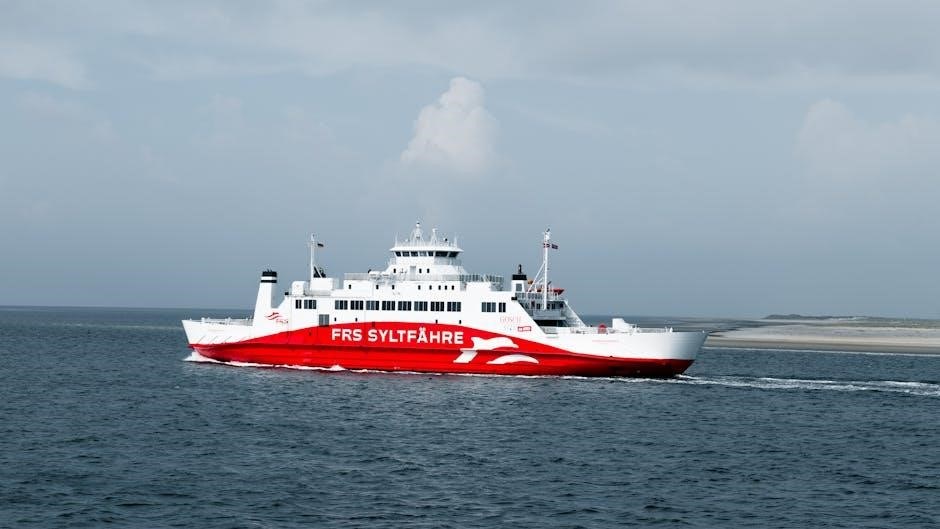The FRS Strategy is a comprehensive framework designed to enhance the efficiency, effectiveness, and safety of fire and rescue services, aligning operations with organizational mission and goals.
1.1 Definition and Scope of FRS Strategy
The FRS Strategy is a structured approach to enhancing the operational efficiency and effectiveness of fire and rescue services. It encompasses a wide range of activities, including risk management, resource allocation, and procurement processes. The strategy is designed to align with the broader goals of public safety, ensuring that services are delivered in a sustainable and cost-effective manner. It also incorporates elements of continuous improvement, allowing for adaptability to emerging challenges and technological advancements. The scope of the FRS Strategy extends to Deer Management Programs, investment plans, and performance measurement frameworks, ensuring a holistic approach to service delivery. This strategy is essential for maintaining professionalism and effectiveness in fire and rescue operations.
1.2 Importance of Strategic Planning in FRS
Strategic planning is crucial for ensuring the Fire and Rescue Services (FRS) operates effectively and efficiently. It provides a clear roadmap for achieving long-term goals, aligning resources with objectives, and addressing emerging challenges. By fostering a proactive approach, strategic planning enables FRS to anticipate risks, optimize resource deployment, and enhance response capabilities. It also supports continuous improvement, allowing services to adapt to changing demands and technological advancements. Effective strategic planning ensures accountability, transparency, and sustainability, ultimately improving public safety and trust in the FRS. This process is vital for maintaining professionalism and delivering high-quality services that meet the needs of the community.

Key Components of FRS Strategy
The FRS Strategy comprises key elements such as mission and vision statements, strategic objectives, core values, and operational plans, ensuring alignment with organizational goals and community needs.
2.1 Mission and Vision Statements
The mission and vision statements are foundational to the FRS Strategy, defining its purpose and aspirations. The mission statement outlines the core objectives, such as ensuring public safety, preventing fires, and providing emergency response. It reflects the commitment to professionalism and community protection. The vision statement, on the other hand, sets a long-term goal, aiming for a future where communities are safer and more resilient. Together, these statements guide decision-making, resource allocation, and operational priorities; They also serve as a compass for stakeholders, ensuring everyone works toward common goals. By aligning actions with these statements, the FRS Strategy ensures clarity and focus in its efforts to safeguard lives and property.
2.2 Strategic Objectives and Goals
Strategic objectives and goals within the FRS Strategy provide clear direction for achieving its mission and vision. These objectives are specific, measurable targets that outline priorities such as enhancing emergency response times, improving fire prevention education, and modernizing equipment. Goals are actionable steps toward these objectives, ensuring progress is trackable. For instance, a strategic objective might focus on reducing fire incidents by 20% through community outreach, while a corresponding goal could involve conducting quarterly safety workshops. By structuring objectives and goals, the FRS Strategy ensures a focused approach to resource allocation and performance evaluation, ultimately driving the organization toward its long-term vision of a safer community.
2.3 Core Values and Principles
Core values and principles serve as the foundation of the FRS Strategy, guiding decision-making and operations. These values include professionalism, integrity, and a commitment to community safety. They emphasize the importance of ethical practices, accountability, and transparency in all activities. Principles such as collaboration, innovation, and inclusivity ensure that the strategy remains adaptive and responsive to evolving challenges. By embedding these values, the FRS Strategy fosters a culture of trust, continuous improvement, and shared responsibility. These principles also ensure that resources are used efficiently and effectively, aligning with the organization’s mission to protect lives, property, and the environment. Ultimately, they provide a moral and operational compass for achieving long-term success and stakeholder confidence.

FRS Investment Plan

The FRS Investment Plan is structured to optimize returns through diverse investments, offering flexibility for participants to allocate assets based on risk tolerance and financial goals.
3.1 Overview of the FRS Investment Plan
The FRS Investment Plan provides a structured approach to managing retirement savings through employer and employee contributions. It offers a defined benefit plan and an investment plan, allowing participants to choose from various investment options. The plan is designed to ensure long-term financial security, with returns based on market performance and fees. Participants can adjust their investment strategies according to risk tolerance and retirement goals. The plan also includes educational resources and advisory services to assist members in making informed decisions. Regular reviews and updates ensure the plan remains aligned with economic trends and member needs, promoting sustainable growth and financial stability.
3.2 Benefits and Risks of the Investment Plan

The FRS Investment Plan offers numerous benefits, including financial security, flexibility in investment choices, and potential long-term growth. It provides a structured approach to retirement savings, allowing participants to align their strategies with personal goals and risk tolerance. However, the plan also carries risks, such as market volatility, which can impact investment returns. Management fees and charges may reduce overall gains, and improper diversification can lead to financial instability. Additionally, reliance on employer and employee contributions means that funding levels may fluctuate. Participants must carefully evaluate their options and consider seeking professional advice to mitigate risks and maximize benefits. Regular monitoring and adjustments are essential to ensure the plan remains aligned with individual and organizational objectives.
3.3 Role of Employer and Employee Contributions
Employer and employee contributions are fundamental to the FRS Investment Plan, forming the financial foundation for retirement benefits. Employers typically contribute a fixed percentage of an employee’s salary, ensuring a steady inflow of funds. Employees also contribute a portion of their earnings, fostering a shared responsibility model. These contributions are pooled and invested, aiming to generate returns that support long-term financial security. The balance between employer and employee contributions ensures sustainability and fairness, with each party invested in the plan’s success. Regular reviews and adjustments are made to align contributions with economic conditions and organizational goals, ensuring the plan remains viable and beneficial for all stakeholders involved in the FRS strategy.

Risk Management in FRS Strategy
Risk management in FRS Strategy involves assessing potential threats, allocating resources effectively, and implementing adaptive strategies to mitigate risks, ensuring operational safety and efficiency.
4.1 Risk Assessment and Mitigation Strategies

Risk assessment in FRS strategy involves identifying potential hazards and evaluating their impact. Mitigation strategies focus on reducing risks through proactive measures such as training, resource allocation, and technology integration. Continuous monitoring ensures adaptability to emerging threats, fostering a safer operational environment aligned with organizational goals. This approach enhances preparedness and minimizes disruptions, ensuring effective responses to emergencies while maintaining public trust and safety. By prioritizing risk management, FRS strategies aim to create a resilient framework for handling challenges efficiently. This systematic process is integral to achieving long-term sustainability and operational excellence in fire and rescue services. Effective risk management is thus a cornerstone of FRS strategic planning.
4.2 Resource Allocation and Deployment
Resource allocation and deployment are critical components of FRS strategy, ensuring optimal utilization of available assets to meet operational demands. Strategic planning involves distributing resources such as personnel, equipment, and funding based on identified priorities and risk assessments. Effective deployment ensures that resources are positioned to respond swiftly to emergencies, maximizing efficiency and impact. Regular reviews and adjustments are made to align resource allocation with changing needs and emerging challenges. This process supports the overall mission of FRS by maintaining readiness and enhancing service delivery. By strategically deploying resources, FRS can better serve communities, ensuring safety and minimizing risks. This approach is essential for achieving operational excellence and long-term sustainability in fire and rescue services. Continuous improvement in resource management is a key focus area for FRS strategy.
4.3 Continuous Improvement and Adaptation
Continuous improvement and adaptation are integral to the FRS strategy, ensuring the service remains responsive to evolving challenges and community needs. This involves regular monitoring of performance, feedback loops, and data-driven decision-making to identify areas for enhancement. By leveraging lessons learned from past operations and emerging trends, FRS can refine its approaches to deliver more effective outcomes. Adaptation also includes embracing new technologies and methodologies to stay ahead of potential risks and improve efficiency. A culture of continuous improvement fosters innovation, ensuring FRS strategies remain relevant and aligned with long-term goals. This iterative process supports the overall mission by enabling proactive adjustments to maintain high standards of service delivery and operational excellence;

Procurement Strategy for FRS
The FRS procurement strategy ensures cost efficiency, transparency, and value for money by aligning purchasing processes with organizational goals and maintaining ethical standards in supplier selection.
5.1 Procurement Process and Policies
The procurement process for FRS involves a structured approach to ensure transparency and efficiency. It includes needs assessment, supplier selection, contract management, and continuous monitoring. Policies are designed to promote fair competition, value for money, and compliance with legal requirements. The strategy emphasizes ethical practices, ensuring that all procurement activities align with the organization’s mission and goals. Regular reviews and updates to policies help maintain relevance and effectiveness in a dynamic environment. This systematic approach ensures that resources are utilized optimally, supporting the overall objectives of the FRS strategy.
5.2 Supplier Selection and Management
Effective supplier selection and management are critical components of the FRS procurement strategy. The process involves evaluating potential suppliers based on criteria such as quality, reliability, cost-effectiveness, and alignment with organizational values. Once selected, suppliers are managed through clear communication, performance monitoring, and regular feedback. This ensures that expectations are met and relationships are maintained. The strategy also promotes collaboration, fostering long-term partnerships that contribute to mutual success. By adhering to these practices, FRS ensures a consistent and reliable supply chain, which is essential for achieving operational excellence and delivering high-quality services. Transparent and fair dealings with suppliers further enhance the organization’s reputation and trustworthiness.

5.3 Cost Efficiency and Value for Money
Cost efficiency and value for money are cornerstone principles in the FRS procurement strategy, ensuring that resources are utilized optimally to achieve maximum benefits. The strategy emphasizes the importance of conducting thorough cost-benefit analyses to identify the most economical solutions without compromising quality; By implementing robust financial planning and transparent budgeting, FRS ensures that every expenditure aligns with strategic objectives. Additionally, the adoption of competitive tendering processes and the negotiation of favorable contract terms help in securing better value for money. Regular audits and performance reviews further ensure that financial resources are being used effectively, thereby enhancing the overall efficiency of operations and service delivery.
Deer Management Strategy
The FRS Deer Management Strategy focuses on sustainable deer population control, balancing ecological and agricultural needs. It involves establishing local management units to address regional challenges effectively.
6.1 Role of FRS in Deer Management
The FRS plays a pivotal role in deer management by coordinating national and local efforts to control deer populations. This involves implementing strategies to reduce agricultural damage and ecological imbalances. The FRS works closely with stakeholders to ensure sustainable practices, balancing the needs of farmers, conservationists, and hunters. By managing deer populations effectively, the FRS contributes to biodiversity preservation and reduces conflicts between wildlife and human activities. This role is crucial for maintaining a healthy ecosystem and ensuring the long-term sustainability of natural resources.
6.2 Establishment of Local Deer Management Units
The establishment of Local Deer Management Units (LDMUs) is a key initiative under the FRS Deer Management Strategy. These units aim to address deer population challenges at a regional level, ensuring effective coordination between stakeholders. Each LDMU is responsible for monitoring deer numbers, assessing ecological impacts, and implementing targeted control measures. The FRS collaborates with local communities, farmers, and conservation groups to ensure sustainable practices. This decentralized approach allows for tailored strategies that reflect local conditions, fostering cooperation and accountability. The LDMUs also serve as platforms for education and awareness, promoting the importance of balanced deer management for environmental and agricultural health.
6.3 Challenges and Opportunities in Deer Management
Deer management presents significant challenges, including rising populations, habitat expansion, and balancing ecological and agricultural interests. Climate change and land-use shifts exacerbate these issues, requiring adaptive strategies. However, these challenges also offer opportunities for innovation and collaboration. The FRS Strategy emphasizes sustainable practices, fostering partnerships between stakeholders to address deer-related pressures. Technological advancements, such as monitoring tools and data analytics, enhance management effectiveness. Public education and community engagement further support balanced deer populations, promoting biodiversity and reducing conflicts. By addressing these challenges, the FRS Strategy creates opportunities for long-term environmental and economic benefits, ensuring sustainable land management and wildlife conservation.
Performance Measurement and Evaluation
Performance measurement and evaluation are critical for assessing FRS strategy effectiveness, using KPIs, monitoring frameworks, and reporting mechanisms to ensure accountability and transparency in achieving organizational objectives.
7.1 Key Performance Indicators (KPIs)
Key Performance Indicators (KPIs) are essential for measuring the effectiveness of FRS strategies. These metrics assess response times, emergency handling efficiency, resource allocation, and community safety outcomes. KPIs help identify areas needing improvement, ensuring alignment with organizational goals. They also facilitate transparency and accountability, allowing stakeholders to evaluate progress. Common KPIs include incident response rates, firefighter training levels, and public awareness program reach. By tracking these indicators, FRS can refine strategies, optimize resource deployment, and enhance overall performance. Regular KPI reviews ensure continuous improvement, enabling FRS to adapt to emerging challenges and maintain high standards of service delivery. This data-driven approach is vital for achieving long-term strategic objectives and public trust.
7.2 Monitoring and Evaluation Framework
A robust Monitoring and Evaluation (M&E) framework is crucial for assessing the effectiveness of FRS strategies. This framework ensures continuous oversight of strategic goals, identifying progress and areas for improvement. Regular audits, performance reviews, and stakeholder feedback are integral components, providing insights into operational efficiency and alignment with objectives. The framework also incorporates lessons learned, enabling adaptive management and strategic adjustments. By systematically tracking outcomes, FRS can demonstrate accountability, optimize resource use, and enhance service quality. This structured approach supports informed decision-making, fostering a culture of continuous improvement and ensuring that strategic initiatives remain responsive to evolving challenges and community needs. Effective M&E ultimately strengthens the FRS’s ability to achieve its mission and maintain public trust.
7.3 Reporting and Accountability Mechanisms
Transparent reporting and accountability mechanisms are essential for ensuring the FRS Strategy’s effectiveness and fostering trust among stakeholders. Regular reports are generated to document progress, challenges, and outcomes, providing a clear overview of strategic implementation. These reports are disseminated to relevant stakeholders, including governing bodies, employees, and the public, to promote transparency and accountability. Key performance indicators (KPIs) are used to measure achievements and identify areas requiring improvement. Additionally, internal and external audits are conducted to evaluate compliance with strategic objectives and operational standards. Accountability is further reinforced through public forums and stakeholder engagement, ensuring that the FRS remains responsive to community needs and maintains high standards of governance and service delivery. This structured approach ensures that the FRS Strategy is both accountable and effective in meeting its goals.

Future Directions for FRS Strategy
The FRS Strategy aims to embrace innovation, foster strategic partnerships, and ensure long-term sustainability, aligning with emerging trends and community needs for enhanced service delivery.
8.1 Emerging Trends and Technologies
Emerging trends and technologies play a crucial role in shaping the future of FRS Strategy, enabling more efficient and effective service delivery. Advances in data analytics, artificial intelligence, and IoT devices are transforming how fire and rescue services operate, from predictive risk assessment to real-time incident management. Digital platforms are enhancing community engagement and emergency response systems, ensuring faster and more coordinated actions. Additionally, technologies like drones and wearable devices are being integrated to improve operational safety and situational awareness. These innovations not only align with the FRS mission but also drive continuous improvement, fostering a culture of adaptability and excellence in meeting evolving challenges and community needs.
8.2 Strategic Partnerships and Collaborations
8.3 Long-Term Sustainability and Growth
Long-term sustainability and growth are essential for the FRS Strategy to ensure continuous improvement and adaptability in meeting future challenges. By focusing on resource efficiency, strategic planning, and innovation, the FRS aims to maintain its operational capacity while addressing evolving community needs. The integration of emerging technologies and data-driven decision-making supports sustainable practices, enabling the service to allocate resources effectively. Additionally, fostering strategic partnerships and collaborations enhances the FRS’s ability to grow and thrive, ensuring that it remains a reliable and resilient service provider for years to come.
Long-term sustainability and growth are critical components of the FRS Strategy, ensuring the service remains resilient and adaptable to future challenges. By leveraging strategic investments, resource efficiency, and innovative technologies, the FRS can maintain its operational capacity while addressing evolving community needs. Continuous improvement and risk management practices play a pivotal role in sustaining growth, enabling the service to allocate resources effectively. Strategic partnerships and collaborations further enhance sustainability by fostering shared goals and resource optimization. This integrated approach ensures the FRS remains a reliable and forward-thinking service provider, capable of meeting long-term objectives while addressing emerging trends and technologies.




